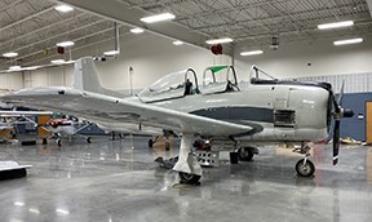A U.S. military airplane built in the mid-1950s to prepare young pilots for flying an array of Vietnam-era jets has been recalled to active (non-military) duty.
The North American Aviation (NAA) T-28C was replaced in the early 1980s by more modern aircraft. Now, one of these historic planes will be used to prepare aircraft sheet metal workers and mechanics for Airframe and Powerplant (A&P) licensure at Canadian Valley Technology Center’s El Reno Campus.
CV Tech has a storied history in support of the aerospace industry. Aviation Maintenance Technology is among just a handful of CV Tech’s oldest programs. For five decades, CV Tech has helped launch the careers of men and women desiring to work in Oklahoma’s No. 1 industry besides energy.
Aerospace and defense employ more than 120,000 people at five military installations, two national guard operations and numerous aerospace support companies. The world’s largest Department of Defense air depot and its largest airline manufacturing, repair and overhaul facility are located here.
Recently, one of CV Tech’s two aviation maintenance instructors went looking for an additional aircraft to complement the school’s fleet, which is used to develop in students a broad knowledge of aircraft systems including installation, overhauling and testing procedures. Students inspect, repair, troubleshoot and maintain aircraft components. The Federal Aviation Administration requires 1,980 hours (or 20 months) for the program, which operates each weekday from August to May and Monday through Thursday in summer months.
John St. Germain, 78, of Houston, has owned a T-28C for nearly a quarter-century, but it had to be registered as a T-28C/St. Germain since it had to be rebuilt from matching parts spread between a building and a field.
St. Germain is a retired U.S. Army combat Infantryman (1964-68) who served during the height of the Vietnam War. He also has an A&P license and relishes the notion that he is giving back to future mechanics and sheet metal workers by donating the aircraft to CV Tech.
“It was a popular aircraft in its day in the mid 50s,” St. Germain said of the T-28C. “It developed it into ground support (for counter-insurgency), and you could do anything but fight other airplanes with it.”
Preserved flight logs indicate the plane was used almost exclusively as a pilot trainer on aircraft carriers. The “C” or “Charlie” version was one of three T-28 versions flown by the U.S Air Force and U.S. Navy. It was intended to approximate the “feel” of the military’s latest jet fighters, according to information supplied by Boeing, which ultimately acquired NAA.
The tandem-seat T-28C was powered by a Curtis Wright R-1820, 9-cylinder radial engine, which generated 1,425 horsepower and a top speed approaching 350 mph. They operated with a 37,000-foot ceiling. The plane has a height of 12.6 feet, a length of 34 feet and a wingspan of 40 feet.
St. Germain bought the plane to fly it but changed the color to suit him.
“I had a paint shop put a Navy gray color on it, but it did once have an orange nose area as if it were used in Navy training,” he said.
Fight logs indicate this aircraft had roughly 9,000 flight hours in the training cycle. St. Germain said the logs also make note of several repairs, presumably minor student accidents.
Tail hook-equipped “Charlies” first took to the skies in September 1955. There were 299 T-28Cs built by NAA for the Navy, and another 72 T-28As were converted for use as “Charlies,” according to Boeing data. They were equipped with smaller three-blade props in order to land them on carriers.
For more information about Aviation Maintenance Technology, call Kristi Stephens, counselor, at (405) 422-2252.

